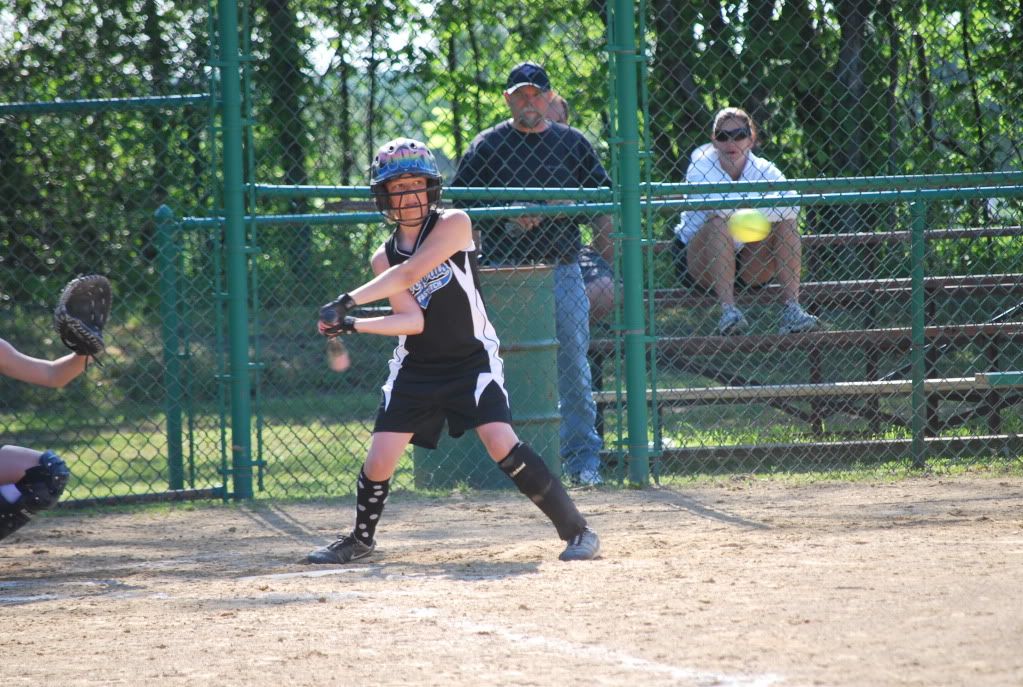Being a lefty is perfect to show this girl how to swing. Just face each other and have her do what you do!..it's like looking in a mirror.
Bretman is correct. This young lady is severe bat drag and chances are it causes early extension thus creating a gate swing. She is also flat-footed and probably has very little or no hip rotation. She also seems to be stepping towards the third baseman but that could be an optical illusion due to the photo angle. Here's what I would suggest:
The set-up:
Have her set up in the batter's where her right foot is about 4 or 5 inches behind the tip of the plate and both feet are about one foot to 14 inches away from the side of the plate. A slightly open stance is okay (front foot about 3 inches further away from the side of the plate than the back foot. Never allow a closed stance.
Since she is wearing batting gloves on both hands I would strongly suggest aligning her "knocking" knuckles (the knuckles you use to knock on a door) when she grips the bat. When she sets up in the batter's box her top hand should be just below and behind her ear, and the bat should angle back and slightly behind back of her head at roughly a 45 degree angle. Her force gripping the bat should be relaxed, just enough to hold on to the bat.
Her stance should be just slightly wider than shoulder width. Her knees should not be locked but they should not have much bend in them either; they should be in a relaxed position. She should have a slight bend at the waist in towards the plate. Her heels should be barely touching the ground because most of her weight should be shifted towards the balls of her feet. Her head position should be where both eyes can see the pitcher without straining and there should not be much tilt in the head.
The swing: (she will need a ton of tee work)
Have her bring her front knee back towards her rear knee, causing her front heel to come slightly off the ground but making sure the big toe of her front foot stays on the ground. At the same exact time her hands should be moving straight back towards the umpire. This is called loading, or trigger, or negative movement. The purpose of this move is to give the batter more force and power to drive the ball. It causes the hitter to "coil" so they can "uncoil" during the forward part of the swing.
Once loaded, have her take a 6 or 7 inch step towards the pitcher, landing on the ball of her foot. Many people call this toe touch. At the same time, have her attack the ball with both her bent front elbow and front shoulder, while the rear arm should travel down towards her rib cage. The tricep of her hear arm should be very close to her body, and her rear elbow should point no further than straight down at the ground between her feet. The batter needs to pull the bat through the hitting zone with her lead arm/shoulder/back rather than pushing the bat through the zone with her rear arm/shoulder/back. This is where a major part of this young lady's swing falls apart. I can't emphasize enough how important it is to attack the ball with a bent front elbow and strong front side.
Once at toe touch, her hips should start rotating, causing her front heel to plant into the ground. Her front knee should now be firm, and it should feel like the weight of her body is going into the front knee and planted foot. This allows the rear foot, during the hip rotation part of the swing, to come up on the toe box of her shoe. Do not have her spin the ball of her rear foot into the ground, and do not let her drag the entire shoe of her rear foot during hip rotation. Upon contact, that rear foot should be up on her "tippy-toe".
During hip rotation, the barrel of the bat should be below her hands but on the same plane as the ball. The ball, believe it or not is actually travelling downward, so the swing needs to be upward and in the same plane. Many people call this swinging level on the ball (not level to the ground), because you are trying to keep the barrel of the bat in the same plane as the ball for as long as possible, giving you an increased chance of making good contact. There should be some bat lag during hip rotation, but at contact the barrel of the bat should be below and slightly in front of the hands. Contact with the ball should be made before the ball gets into her body, in other words hit the ball out in front. Once contact is made her swing should go into full extension, with her hands finishing high and the bat finishing above her front shoulder. Have her swing through the ball, not to the ball.
Len




